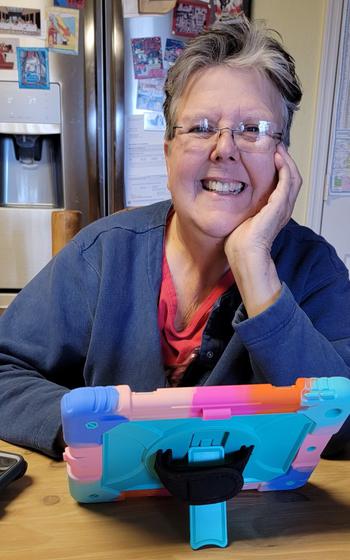
Marilyn Newman on her father Ralph Newman’s shoulder in an undated photo. Ralph Newman drew comics and cartoons for the London edition of Stars and Stripes during World War II and went on to become a cartoonist for major animation studios. He will be honored July 26, 2024, with the Bill Finger Award for Excellence in Comic Book Writing at Comic-Con International in San Diego. (Photo provided by Marilyn Newman)
A World War II veteran who drew cartoons for Stars and Stripes will be honored this month at San Diego’s Comic-Con International for the uncredited work he did after the war, including stories for characters Richie Rich and Casper the Friendly Ghost.
Ralph Newman will receive the Bill Finger Award for Excellence in Comic Book Writing on July 26 as part of the convention that brings together more than 130,000 people each year to celebrate all things comics. The Bill Finger Award is given during the event to honor cartoonists who did not receive recognition for their work.
“There are a lot of people in the history of comics who created enormously wonderful, long, lasting, legendary characters that were worth millions, if not billions, of dollars and who received little to nothing for those efforts,” said Mark Evanier, a writer, historian and administrator for the annual award. “[Newman] did hundreds, if not thousands, of comic book stories, many of which were reprinted over and over, some of which probably were adapted into TV shows. I think that even learned scholars of comics did not even know his name.”
Newman, who died in 1989 at age 75, spent his post-war career working at Terrytoons animation studio, Timely Comics, now Marvel, and Harvey Comics. Though he worked on some of each company’s most famous comics, he rarely received credit in the printed editions, Evanier said. That was common for the time.
Some of Newman’s only credited work appeared in Stars and Stripes as he drew for the paper’s London edition primarily in 1944 and 1945. His work occasionally appeared on the page alongside that of Dave Breger, who created the character G.I. Joe, and Bill Mauldin, who captured the everyday experience of the war through two exhausted soldiers named Willie and Joe.

Marilyn Newman in an undated photo. She will accept with the Bill Finger Award for Excellence in Comic Book Writing at Comic-Con International in San Diego on July 26, 2024, on behalf of her father. Ralph Newman drew comics and cartoons for the London edition of Stars and Stripes during World War II and went on to become a cartoonist for major animation studios. (Photo provided by Marilyn Newman)
Newman attended Albion College in Michigan to study art and journalism, his daughter Marilyn Newman said. After graduation, he moved to New York City where he sold at least one cartoon to The New Yorker magazine and other publications before being drafted into the Army in June 1942.
“He thought he was going to Iceland,” said Marilyn, 69. “But they ended up dumping him off in London. … I know Stars and Stripes was important to him.”
It wasn’t just comics and cartoons that Newman drew for the newspaper. He also added drawings to stories. For a 1945 story on moving supplies to the front lines of the war, Newman contributed drawings to illustrate supply soldiers delivering food, driving truck convoys and collecting enemy scrap metal to reuse it.
“He didn’t see combat, but he kind of lived in it,” Marilyn Newman said.
Her father did tell her stories of calling Paris during the war, trying to reach artist Pablo Picasso. Instead, he found himself on the phone with novelist Gertrude Stein.
“He said he enjoyed talking to her,” she said. “I’m not sure if he was researching something for a story or what. It’s just a fragment memory now.”
Newman left the Army after the war ended as a corporal. While stationed in London, he met his wife, and the two settled in Darien, Conn., where he maintained a drawing studio at home.
Marilyn recalled her father asking her as a child, “What do you think Richie Rich should do now?”
“It was fun watching it happen,” she said.
Her father was able to make a lasting career of drawing cartoons, but he always craved the fame that he saw others in the industry achieve, Newman said.
“I wish he could’ve lived to see [this award],” she said. “He made a lot of money for those companies, and he should be acknowledged for it. It’s different times now, and I’m glad people realize that.”
While the Bill Finger Award is just a small part of the Comic-Con event, Evanier said it is important to give these artists their moment in the spotlight.
“I don’t know as much about Ralph Newman as I probably should, and that’s the problem,” he said. “He’s not been publicized. His story is not publicized. Hopefully giving him this award will cause people to look him up more, and maybe some people who know him to come forward or evidence to be found.”